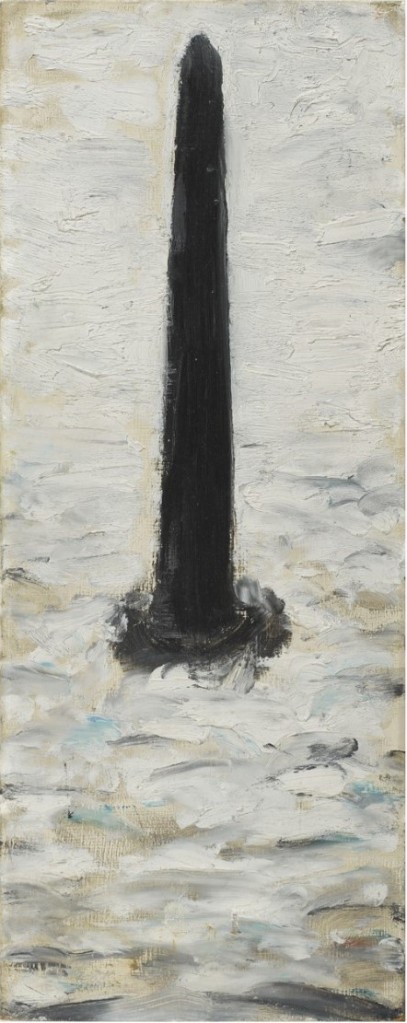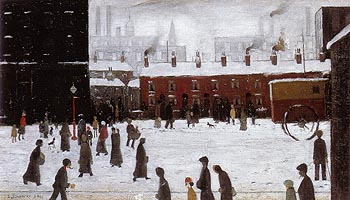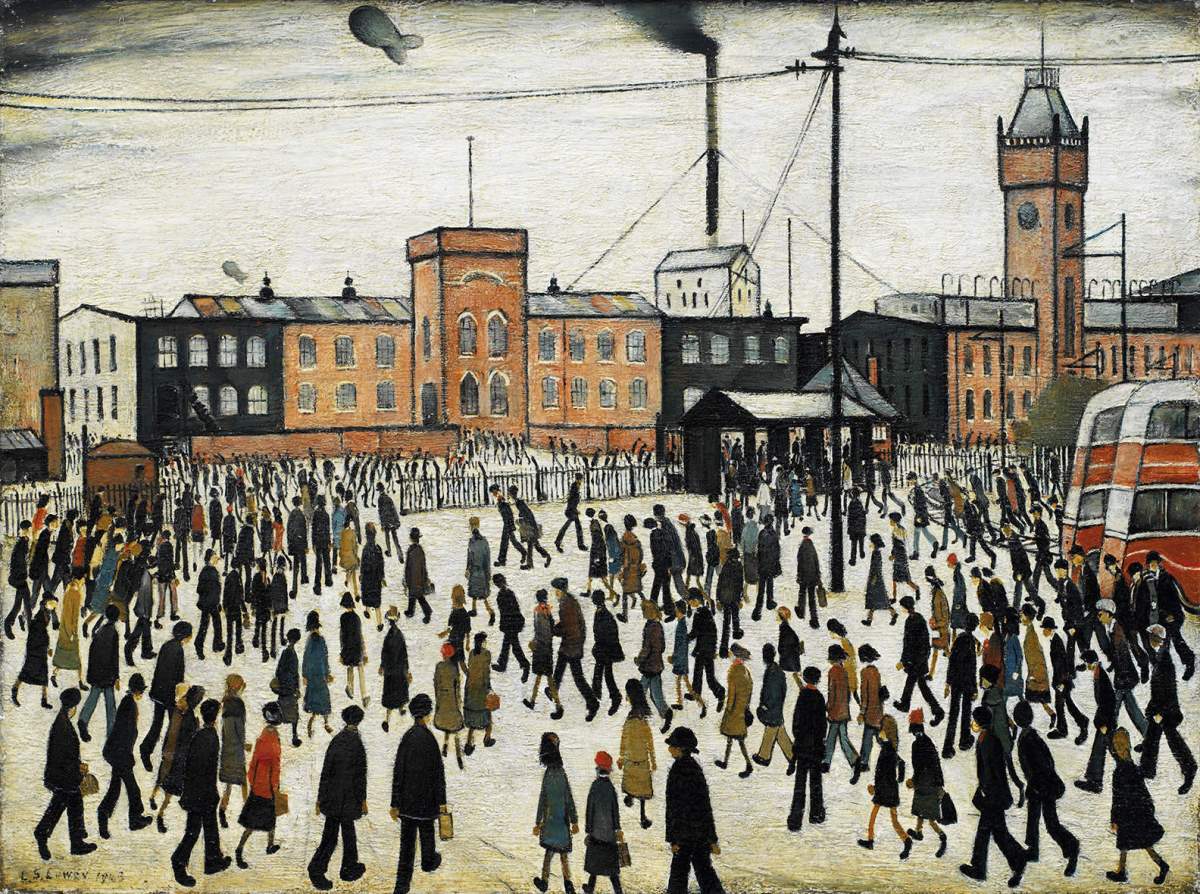Ella Nixon brings our attention to Lawrence Stephen Lowry, the celebrated British painter of the working class, positing that the subjects of his paintings were his feelings of loneliness rather than the everyday struggles of the poor. What can his paintings tell us now, in this moment of social isolation?
A crowd of workers clad in clothing of dark blues, ochres, red, and black, walks away from the viewer without a backward glance. Some hold lunch boxes prepared for the long day ahead; some scurry forwards as if they are going to be late; some trudge towards the factory in an automatic movement. The mills rise as meccas of the industrial landscape. The anonymous people, like a whisper of moths to the light, cluster together in a journey towards the iron gates to begin their shifts at the mills. Going to Work (1943) illustrates how social distancing in twentieth-century industrial Manchester was an alien concept.
Laurence Stephen Lowry (1887-1976), in a repetitive fashion, produced a copious portfolio of paintings which depicted urban crowds. His job as a rent collector for the Pall Mall Property Company brought him into close contact with the working-class inhabitants of Salford and he came to know the streets intimately. The 2013 Tate Britain exhibition, Lowry and the Painting of Modern Life, curated by T. J. Clark and Anne M. Wagner, gave expression to these works. In the exhibition catalogue, they designated Lowry ‘as essentially a painter of the industrial city and its working class’.[1] In a rather Baudelairian fashion, therefore, Lowry was declared to be the painter of modern life. This article, however, will discuss Going to Work from a different angle to the modernity explored by the Tate exhibition: it will consider the nature of isolation in the twenty-first century.
In the winter of 1907-1908, Lowry attended an Impressionist exhibition. Here, Lowry could peruse the paintings of Impressionist masters, including Degas, Pissarro, and Manet. Despite expressing some admiration, he criticised the paintings because he ‘didn’t see the battle of life in them’.[2] Yet, he does not specify what ‘battle of life’ he was seeking in the Impressionist works. His admiration for Honoré Daumier’s paintings of dismal working-class subjects suggests that one of these battles was intended as the poverty and politics of the poor. A consideration of his later seascapes, however, suggests the ‘battle of life’ for him were his personal feelings of isolation.
The industrial scenes produced by Lowry are painted from an elevated perspective. The artist, invisible for the viewer, regards the bustling crowd from a distance. Despite entering the homes and drinking tea with his subjects as part of his job as a rent collector, Lowry admitted that he ‘did not care for them [his subjects] the way a social reformer does.’[3] Therefore, isolation from the bustling crowds was inherent in both the process and explicit in the perspective. It begs the question, in a time of social isolation, what is isolation and does it necessarily stem from the reduction of social contact?
The government imposed lockdown revolves around the phenomenon of social distancing. However, the isolation experienced by Lowry did not emanate from lack of human contact. Although the press presented Lowry as a recluse, the variety and number of friends he saw daily attest otherwise. Instead, his isolation was a psychological state rather than something we can use as a tape measure to numerically grasp.
Despite being surrounded constantly by people in busy Salford, it was the death of his mother which triggered his feelings of deep isolation. One of his closest friends described how ‘[e]ven if you had been quite intimate with him, you couldn’t ask him personal questions.’[4] In the 1940s, Lowry began to produce desolate seascapes after the death of his mother. Lowry’s Self Portrait as a Pillar in the Sea (1966) (Figure 2) conveys a deep sense of loneliness despite his constant contact with friends. He portrays himself as a lone pillar surrounded by the endless waves of the sea.

At a time when daily briefings report deaths in the hundreds and when people scroll anxiously through the news, it is easy for anxiety to disguise itself as isolation. In industrial Manchester, death was also visible daily on the streets. The omniscient presence of the fever van in many of Lowry’s paintings, such as Street Scene in the Snow (1941) (Figure 3) attest to this. However, the case of Lowry highlights the nature of isolation: he felt detached from a class of people he did not associate with and the death of a close one caused his loneliness.

Lowry felt closest to his mother and, as he reported, sometimes these feelings of grief were overwhelming. After her death, he initially found it difficult to paint. He reported thirty years after the death that ‘I had no interest in life after my mother died’.[5] However, with time he came to cope with his feelings of isolation through painting. Michael Howard describes how, in his old age, the ‘relationship with his paintings developed into something rather like that of a father with his children’.[6] It was through his paintings that Lowry found his purpose and contact with life.
In these times, the message seems clear: keep contact with those who are closest to you and, alongside or at least, find purpose. In times of isolation – whether imposed by the lockdown or otherwise – contact with those who mean the most to us is paramount. It does not matter that the streets are not bustling, bars are closed, and parties are cancelled. In these environments, we can sometimes feel like the detached observer who surveys the crowd, or in Lowry’s case the crowds of workers on their way to the mills.
Lowry also shows us how, when contact is completely cut off, we must find purpose. The figures of Going to Work, like automata, were drawn to the mills. However, lest we confuse human company with lack thereof and dangers arise of losing a sense of purpose in life. Cultivate your interests and create that connection with yourself to share with others. Self-isolation need not be isolation.
[1] T. J. Clark and Anne M. Wagner, Lowry and the Painting of Modern Life (London: Tate Publishing, 2013), 18.
[2] Michael Howard, Lowry: A Visionary Artist (Salford Quays: Lowry Press, 2000), 19.
[3] Ibid., 123.
[4] Shelley Rohde, A Private View of L. S. Lowry (London: Book Club Associates, 1979), 116.
[5] Ibid., 144.
[6] Howard, Lowry: A Visionary Artist, 21.
Further Readings:
- Clark, T. J. and Anne M. Wagner. Lowry and the Painting of Modern Life. London: Tate Publishing, 2013.
- Howard, Michael. Lowry: A Visionary Artist. Salford Quays: Lowry Press, 2000.
- Rohde, Shelley. A Private View of L. S. Lowry. London: Book Club Associates, 1979.
Ella Nixon is a History of Art MA student at The Courtauld Institute of Art specialising in twentieth century European art. Ella’s research interests lie in the curation of gender and postcolonialism, post-modern art, and the artworks of L. S. Lowry.
